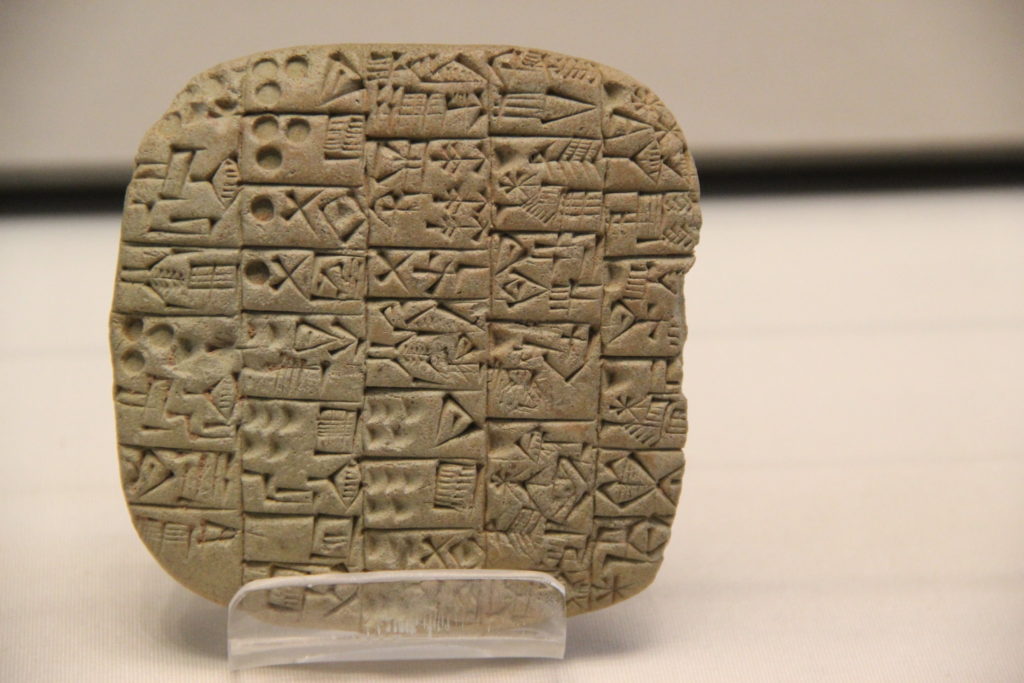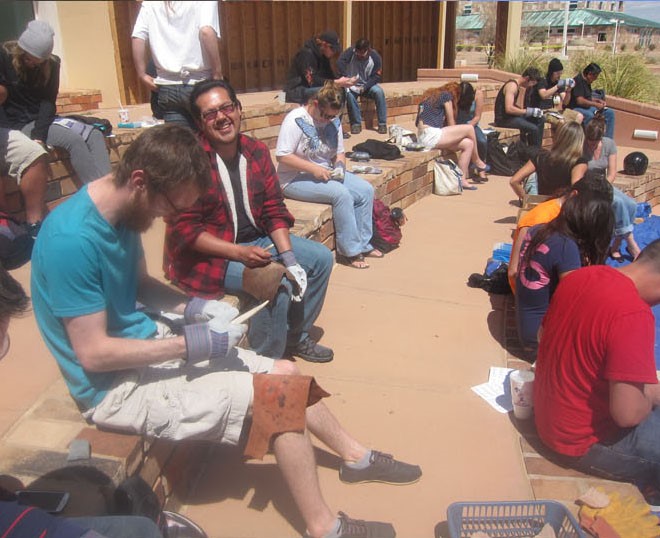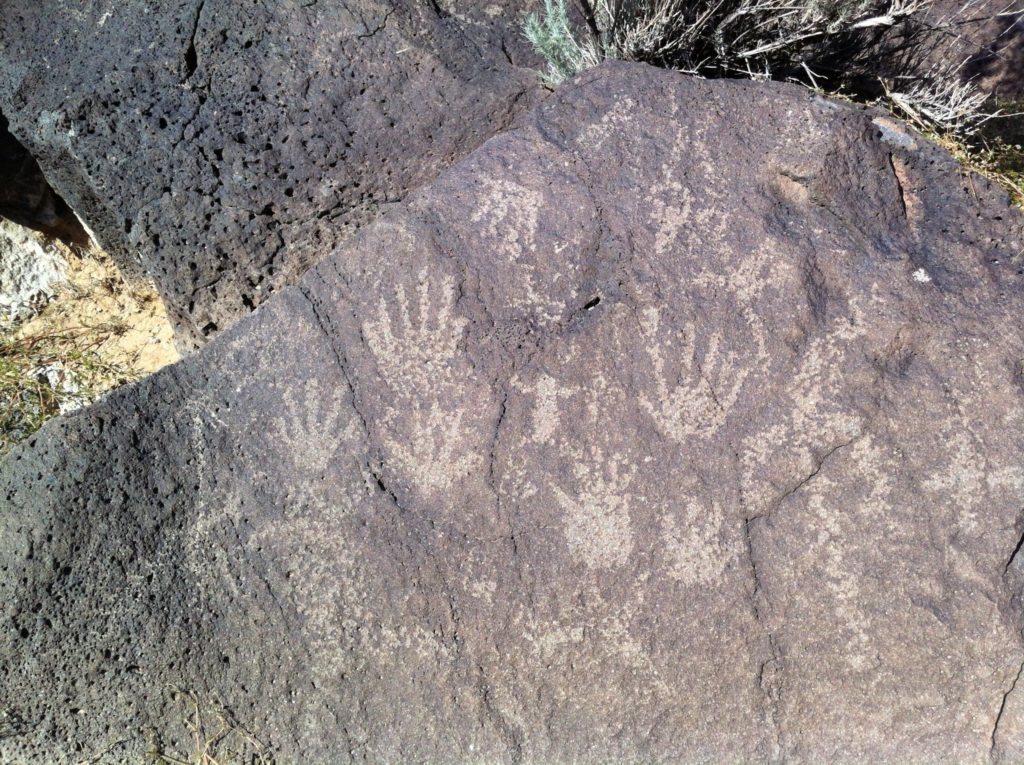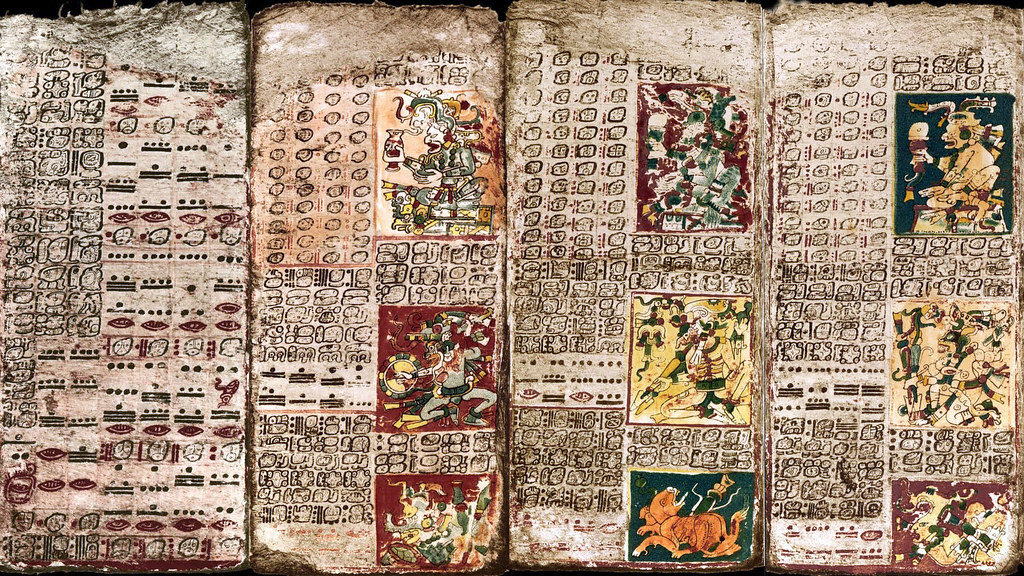Hands at Piedras Marcardas by Ian Irving is licensed under CC BY 2.0
Archaeology is only partly about discovering things; for me, archaeology is about thinking about things. —Stephen Lekson
Taking a noon-day break from excavating on Albuquerque’s windswept West Mesa in the summer of 2002, we stretched our legs, cramped from kneeling in a small square pit since six that morning. Someone started a game of hacky sack. Reaching down to retrieve the hack, I saw something black and shiny in the sand. “Gotta be cultural,” I thought. The crew gathered around, and we soon realized that I held in my hand an obsidian Folsom point, a kind of spear tip made of volcanic glass. The person who last touched the point lived more than 10,000 years ago, at the close of the last ice age. The artifact and its maker belonged to a different geological epoch—the Pleistocene—also known as the ice ages. Ultimately, our excavation would show that a small band of people was hunting a species of giant bison at the edge of a small lake. The point, along with other artifacts recovered at the site and the context in which they were found, is a portal to the past. Within 10 years, the area would be transformed into a modern neighborhood on Albuquerque’s Westside.
Who hasn’t thought about traveling in time to the distant future or the remote past? I would love to spend one day hanging out with ice-age humans, witnessing the Easter island moai being carved and moved, or simply stand on the same sands as the Egyptian Sphinx and pyramids in their heyday. While we can’t blast back in time through a wormhole or in a tricked-out DeLorean, we humans can go anywhere in our minds, free of charge. This mental time travel may not be unique to humans, but certainly, no other animal is obsessed with the past and future like human beings. We are captivated by stories of galactic wars of long ago, a future planet ruled by apes, and the daring deeds and misdeeds of our ancestors. These are not mere stories, but shared narratives that bind us together and shape how we view the world. Archaeology is a kind of story-making, but one grounded in the physical facts, and important to understanding who we are as a species.
Our interest in the past is not just a modern obsession. The ancient Maya, who were fanatics for calendars and tracking time, inscribed dates well into the 5th millennium A.D.—the 4,000s. In this course, we’ll take a journey to our planet’s human past, visiting those who have come before us and stood where we now stand, whether it’s the West Mesa of Albuquerque or the Valley of the Kings in Egypt. We’ll examine who these people were, what were their lives like, and how have they shaped who we are today. We will also consider the ethical questions of who gets to tell these stories, who gets to visit sites, what kinds of artifacts should be displayed, and whether some things are better left in the ground or reburied.
Writing and Material Culture
Short of a time machine, one way to know the past is to read what people have put down in writing. Of course, spoken language and oral traditions are much older than writing, which has only existed for around five thousand years. Even when writing systems were in place, many of the stories of the ancient world were not written down, but instead recited orally as poems, songs, and narratives. German fairy tales were terrifying children long before they were put to paper by the Brothers Grimm. Even though Homer’s the Iliad and Odyssey were immortalized in writing, they continued as oral traditions alongside their written counterparts. Religious stories of the Bible, Torah, and Vedas were originally orally transmitted. For indigenous people of North America oral traditions were and continue to be important ways of passing along histories and cultural values. Today, oral traditions are even used to connect archaeological remains to modern-day tribes.
The term “history” is often defined as the study of written documents. Early writing did not emerge everywhere, but rather only in a few areas like the Middle East, China, Egypt, India, and Mesoamerica. The written word can have a powerful, almost magical quality. The ancient Maya revered the writings of their ancestors and believed that reading ancient texts literally brought their ancestors back to this plane of existence, a literal portal. Not so differently, the astronomer Carl Sagan wrote of the magical quality of books in Cosmos,
“One glance at it and you hear the voice of another person, perhaps someone dead for thousands of years. Across the millennia, the author is speaking, clearly and silently, inside your head, directly to you. Writing is perhaps the greatest of human inventions, binding together people, citizens of distant epochs, who never knew one another. Books break the shackles of time―proof that humans can work magic.”
Despite its power, writing is also a fragile medium. The ambition of the Library of Alexandria, built more than 2,000 years ago, was to collect all the written knowledge in the world and house it under one grand roof. Hundreds of thousands of papyrus scrolls are thought to have been curated there. Portions of the library were infamously burned by Julius Caesar in 48 B.C. But equally devastating was the neglect the library received with changes in ruling parties. As different leaders came to rule the city under the influence of various religious ideologies, the knowledge contained within the library came to be viewed as a threat, and the once-thriving library deteriorated due to lack of funding and neglect.
In perhaps an even more drastic example, Catholic bishop Diego de Landa intentionally burned nearly all the Maya codices (books), regarding them as blasphemous texts. More recently, ISIS burned thousands of books and manuscripts in the libraries of Mosul, Iraq. As writer Robin Wright (2017) put it, “ISIS sought to kill the ideas within its walls—or at least the access to them.” Written documents continue to be susceptible to loss today. One prevailing concern is how will we store the unprecedented amount of data we generate today. Our storage devices will likely be obsolete just a few years from now, making storage of information as tenuous as ever. In a surprising twist, scientists are considering using DNA to store data indefinitely, with the benefit of being able to store huge amounts of data, circumventing the problem of picking and choosing the information to save. Some suggest we have the potential to save all of it (Zielinski 2017).

“Sumerian Cuneiform Clay Tablet” by Gary Todd is licensed under the public domain.
Prehistory is the term often used to describe the study of times and places that did not have written records. Most of “history” is in fact prehistory, because, for most of human existence, there was no form of writing. The term “prehistory” is a bit loaded because it makes writing a kind of benchmark of success and casts writing as a hallmark of human progress. In reality, not every culture needed written records, which had its origins in the ignominious task of keeping track of debts and taxes. What’s more, it was not uncommon for only the wealthy elite to be educated in reading and writing, while peasants remained illiterate. We see this today in some societies where certain people, like girls, are denied an education and are illiterate, whereas boys and men can read and write. From this perspective, a culture can be simultaneously historic and prehistoric.
Since we are unable to read documents from cultures that lack writing systems, we must instead rely on something called material culture, or physical things that people left behind. Archaeologists specialize in understanding the past through these material residues. Material culture has some advantages over written documents. First, it tends to be more durable than written records. Sometimes, the durability of material culture is quite surprising. Archaeologist Bill Rathje’s famous garbology project unearthed a 1940s-era hotdog from the “Fresh Kills” landfill on Staten Island (Rathje and Murphy 2003). While more durable, material culture is not invulnerable, as when the National Museum of Brazil burned in 2018 as a result of underfunding, neglect, and the absence of a sprinkler system. Second, everyone leaves behind traces of their existence, so archaeologists are not limited to studying just the kings and queens and their great conquests and accomplishments. Through material culture, archaeology can investigate everyday people’s existence, not merely the pharaohs and priest-kings who actively tried to preserve their legacy through writing.
Another disadvantage of written records (and oral accounts) is that they are often biased, inaccurate, and sometimes outright fabrications. As New York Times writer Witold Rybczinski (1992) put it, “Garbage doesn’t lie. The evidence of junk-food wrappers, liquor bottles, and girlie magazines often flies in the face of what we tell ourselves—and what we tell others—about what we do.” If we relied solely on self-reporting and written accounts of history, we’d have a warped and overly flattering understanding of current and past human behavior. Imagine if we only had our social media posts and images from which to reconstruct past lives and events.
Dresden Codex by Chris Protopapas is licensed under the public domain
In the United States, archaeology is often classified as a subfield of anthropology. Anthropology is the study of people from a holistic perspective, considering all aspects of their humanity—culture, language, biology, as well as their past. Holistic simply means that anthropologists are interested in humanity as a whole, and not just one aspect of our species. Anthropologists want to understand how entire past societies operated. As mentioned, anthropology, and therefore, archaeology, is interested in everyone—peasants, merchants, artisans, scribes, soldiers, priests, slaves—not just the glamorous, high-profile celebrities of the past. In other countries like Great Britain, archaeology is considered a division of history. Wherever archaeology is situated from an academic point of view, the boundaries between archaeology and other areas of inquiry are largely artificial. Archaeology draws on many disciplines—biology, history, political science, economics, psychology, geography, and sociology. Truth be told, archaeologists routinely use both written documents and material culture to investigate what our human ancestors were up to.
In addition to being concerned about the human past, archaeology is increasingly interested in how the past has shaped the present and how it will impact the future. Subjects like environmental destruction, plant and animal extinction, and the concentration of political power are recurring themes in archaeology. A cursory look at ancient civilizations reveals that we are not the first to modify our landscape beyond recognition, use resources unsustainably, or concentrate power in the hands of a few. The empty ancient ruins of the Americas, the Middle East, Egypt, Europe, Africa, and Asia should give us pause to reflect on our own civilization and what the future will bring.
Every discipline has a foundation and methods with which they seek to build knowledge. Knowing is especially challenging in archaeology because of the time elapsed since the events occurred. The verb “to know” is one of those rare words that is universal, found in all languages. Knowing is the cornerstone to understanding. Epistemology is a very useful term that refers to how we know what we know. You can think of it as “knowledge-ology”, the study of how we know things. What constitutes a good method, good evidence, and reasonable inferences? These are questions that are debated in every discipline, not just archaeology. Archaeologists generally try to test hypotheses, which are informed guesses that can be tested. A theory, in contrast, is a well-tested idea that has stood up to rigorous attempts to disprove it. Since scientists are in the business of proving each other wrong, when an idea gets elevated to the theory level, it’s a big deal. Examples of theories include the germ theory of disease, atomic theory, the theory of relativity, and evolutionary theory.
Archaeologists are interested in both large- and small-scale questions. Small-scale questions are straightforward such as What was in this pot? Where did this stone come from? What did this person eat before he died? Large-scale questions that interest archaeologists include things like: Why did the domestication of animals and plants emerge? Why did some areas develop cities while others did not? Why do civilizations collapse and disappear? Archaeology considers these types of questions and everything in between. Often there are different levels of confidence when investigating the past. We can generally be more confident about things like diet, trade, tool use, and construction techniques than we are about the large-scale “why questions” of the past. Additionally, understanding the values and symbols systems of past societies is quite challenging, and yet is one of the most interesting aspects of archaeology and targets what we often think of as human culture—that complex web of shared meaning that underpins how we see the world.
While hypothesis testing is common in archaeology, there are different methods to test those hypotheses. Some archaeologists collect quantitative data. Quantitative data is measurable information. An archaeologist, for instance, might measure the length of projectile points, count the number of pollen grains in a soil sample, or record the quantity of animal bone on a site. Other archaeologists are more interested in qualitative information, that is, descriptive information. Archaeologists interested in art and the use of symbols might be more interested in describing the nature of the artwork and its context. Of course, this is a simplified dichotomy, and archaeological studies routinely consider both quantitative and qualitative data simultaneously. Indeed, archaeologists regularly use many different types of data and lines of evidence to investigate a question.
Archaeology draws heavily on sciences including biology, genetics, chemistry, and physics. These applications of scientific techniques are collectively called archaeological science. For example, archaeologist Patty Crown at the University of New Mexico along with Jeffrey Hurst of the Hershey Corporation, discovered the chemical signature for cacao in ancient cylindrical vessels at Chaco Canyon, New Mexico using a technique in chemistry called chromatography (Crown and Hurst 2009). Not only does this research show that liquid chocolate was in the ceramic vessels, but also because cacao does not grow in New Mexico today, we know there must have been extensive trade to the south. The research sets the stage for archaeologists to further develop and test questions of trade and exchange between the American Southwest and other regions.
Another approach that archaeologists have used to gain insight into past behavior and to test hypotheses is experimental archaeology. Experimental archaeology replicates ancient objects and activities to gain insight into the past. The usefulness of reconstructing the conditions of the past is that the reveals whether a particular activity or solution was possible. Unlike archaeological science, experimental archaeology is not the “white lab coat” kind of investigation. For instance, archaeologist Bruce Huckell at UNM wanted to know if a certain type of stone spear point could penetrate the hide of a mammoth. When an elephant at the local zoo died, Huckell (1982) showed that stone points could penetrate the elephant skin, which had similar quality and thickness as mammoth skin. By reconstructing the conditions of the past, Huckell demonstrated that the spear points in question could have been used to hunt mammoths. Recreating the stone tools themselves is another example of experimental archaeology. In my face-to-face courses, I often invite Ron Fields, an archaeologist at Salinas Pueblo Missions National Monument in New Mexico and an expert in stone tools, to show students the basics of making stone tools, also known as flint knapping. By attempting to make stone tools for themselves, students can experience first-hand the challenges people faced when making stone tools.

CNM Students learn the basics of stone tool manufacture. Photo: Sue Ruth
Archaeology, like many disciplines, has different schools of thought or paradigms. Some archaeologists are more interested in how ecological factors like climate, population size, and access to resources influence human behavior. Others are more interested in the values, symbolic systems, and power structures of the past. When learning about archaeological research, it is useful to think about how an archaeologist is approaching a problem and the lines of evidence used to answer questions about the past. Archaeologists interested in different aspects of the past typically collect different types of information, use different techniques, and make different kinds of inferences. Some questions to ask yourself when you read about archaeological studies are: Is this a small or large-scale question? What kind of techniques is the archaeologist using? Does the archaeologist use quantitative or qualitative information? What evidence is presented? What is the archaeologist’s general approach? Answering these kinds of questions will be useful in both understanding and evaluating archaeological claims.

